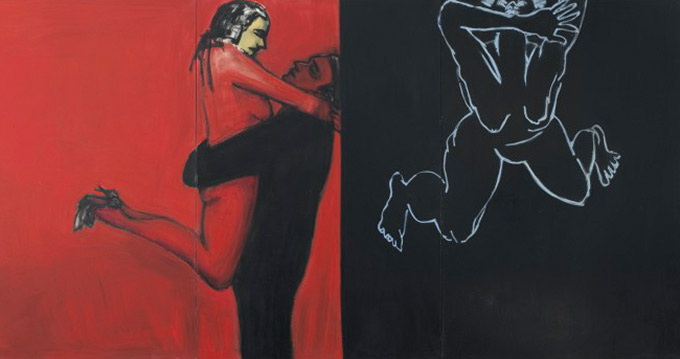Reflections on the works of Jackie Felix at the Burchfield-Penney Art Center
by J. Tim Raymond

A Body—Just That
Attending the reading by Al Felix, a memento mori to his late wife, Jackie, held at Indigo Gallery two Sundays past, I witnessed a poignant tribute to a woman I had known as a friend and fellow artist for more than 20 years. As Al spoke his loving, poetic words, I took in the artwork on the walls around us, and the assembled friends of Jackie Felix, and thought about her imagery.
I had always felt ambivalent about her portrayal of couples and the human detachment that pervaded so much of her art. Her conversations with me during our years together at Hallwalls and in visits to her home and studio were always entertaining, constructive exchanges—the furthest thing from the harassed, repressed and alienated individuals she chose to paint. Her theatrical scenes of men and women were rarely commiserative, emotionally charged, often outright violent. Her best work was boldly provocative both sexually and politically—intensely exaggerated in energy of style and restrained color, even when concerned with the most quotidian moments of conjugality: drinking coffee, reading the paper, getting ready for bed. Her images combined the sense of longing in Edward Hopper’s paintings, the statuesque presence of Alex Katz, the mental acrobatics of Eric Fischl, and the bicameral format of David Salle. They brought to mind, visually, the minimalist structure of a short story, perhaps something by Raymond Carver, John Cheever, Ann Beatie, even Salinger in his excruciating piece, “Pretty Mouth and Green My Eyes.” As mordantly modern as any of Ingmar Bergman’s stormy domestic dramas, Felix’s depictions of ruinous relationships offer little hope of reconciliation. Her figures, if not totally naked, wear shirts and ties, women rarely more than underwear and heels. In their invidious expressions, inwardly gazing but somehow clueless, they sit or stand in mute accusation of one another, leaving resolution or resignation heavy on women’s bare shoulders (prominent in her compositions).
Her quickly brushed painting style conveys a sense of faith’s impermanence, the bruising weight of thwarted desire, deferred passion—the spiteful soap opera strategies and shadowy lives of couples in harness, straining at the bit.
blog comments powered by Disqus|
Issue Navigation> Issue Index > v11n7 (Mardi Gras Issue, week of Thursday, February 16) > Art Scene > Reflections on the works of Jackie Felix at the Burchfield-Penney Art Center This Week's Issue • Artvoice Daily • Artvoice TV • Events Calendar • Classifieds |









 Current Issue
Current Issue